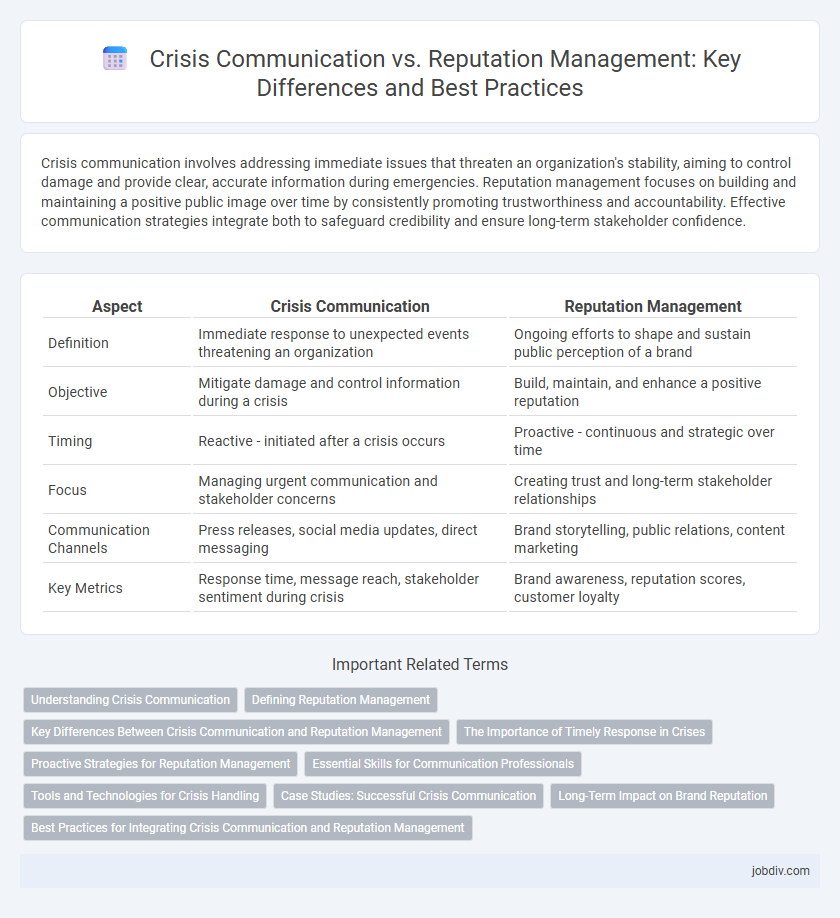Crisis communication involves addressing immediate issues that threaten an organization's stability, aiming to control damage and provide clear, accurate information during emergencies. Reputation management focuses on building and maintaining a positive public image over time by consistently promoting trustworthiness and accountability. Effective communication strategies integrate both to safeguard credibility and ensure long-term stakeholder confidence.
Table of Comparison
| Aspect | Crisis Communication | Reputation Management |
|---|---|---|
| Definition | Immediate response to unexpected events threatening an organization | Ongoing efforts to shape and sustain public perception of a brand |
| Objective | Mitigate damage and control information during a crisis | Build, maintain, and enhance a positive reputation |
| Timing | Reactive - initiated after a crisis occurs | Proactive - continuous and strategic over time |
| Focus | Managing urgent communication and stakeholder concerns | Creating trust and long-term stakeholder relationships |
| Communication Channels | Press releases, social media updates, direct messaging | Brand storytelling, public relations, content marketing |
| Key Metrics | Response time, message reach, stakeholder sentiment during crisis | Brand awareness, reputation scores, customer loyalty |
Understanding Crisis Communication
Crisis communication involves the rapid and strategic exchange of information during emergencies to mitigate damage and maintain public trust. It prioritizes transparent, accurate messaging aimed at minimizing confusion and controlling the narrative in high-pressure situations. Effective crisis communication integrates real-time monitoring and stakeholder engagement to swiftly address concerns and uphold organizational stability.
Defining Reputation Management
Reputation management involves strategically monitoring and influencing public perception to maintain or enhance an organization's image. It encompasses proactive efforts such as brand positioning, consistent messaging, and stakeholder engagement to build trust and credibility. Effective reputation management minimizes the impact of negative publicity and fosters long-term loyalty among customers and partners.
Key Differences Between Crisis Communication and Reputation Management
Crisis communication focuses on addressing urgent, unexpected events that threaten an organization's stability, emphasizing immediate response and transparency to mitigate damage. Reputation management involves long-term strategies to build, maintain, and improve public perception through consistent messaging and stakeholder engagement. While crisis communication is reactive and short-term, reputation management is proactive and ongoing, both critical for overall brand resilience.
The Importance of Timely Response in Crises
Timely response in crisis communication is crucial for minimizing damage and maintaining stakeholder trust, as delays often amplify misunderstandings and negative perceptions. Rapid, transparent updates help control the narrative and demonstrate organizational accountability during volatile situations. Effective crisis communication, when executed promptly, supports reputation management by preventing misinformation and preserving brand integrity.
Proactive Strategies for Reputation Management
Proactive strategies for reputation management involve monitoring public sentiment, engaging with stakeholders regularly, and addressing potential issues before they escalate into crises. Implementing transparent communication policies and consistent brand messaging builds trust and strengthens the organization's image over time. Leveraging social media analytics and sentiment analysis tools enables early detection of negative trends, allowing timely interventions that protect and enhance reputation.
Essential Skills for Communication Professionals
Effective crisis communication requires rapid decision-making, transparency, and empathy to manage immediate threats and maintain public trust. Reputation management emphasizes long-term strategic thinking, consistent messaging, and relationship-building to shape public perception over time. Communication professionals must master active listening, adaptability, and cultural competence to excel in both domains and safeguard organizational integrity.
Tools and Technologies for Crisis Handling
Crisis communication employs real-time monitoring tools like social media analytics platforms and mass notification systems to quickly identify and respond to emerging issues, minimizing damage. Reputation management utilizes sentiment analysis software and customer feedback management systems to track public perception and maintain brand trust over time. Both rely on integrated communication dashboards and AI-driven insights to enhance decision-making and streamline crisis handling processes.
Case Studies: Successful Crisis Communication
Successful crisis communication case studies highlight swift transparency, consistent messaging, and stakeholder engagement as key factors in mitigating reputational damage. Examples such as Johnson & Johnson's Tylenol recall in 1982 demonstrate how immediate action and open communication restored public trust. These cases underscore the integration of crisis communication strategies within broader reputation management frameworks to reinforce organizational credibility.
Long-Term Impact on Brand Reputation
Crisis communication addresses immediate threats to brand reputation through rapid response and transparent messaging, minimizing short-term damage. Reputation management involves ongoing strategies to build brand trust, credibility, and positive public perception over time. Sustained efforts in reputation management ensure resilience and recovery from crises, securing long-term brand equity and stakeholder loyalty.
Best Practices for Integrating Crisis Communication and Reputation Management
Effective integration of crisis communication and reputation management requires establishing a transparent communication protocol that ensures timely, accurate information dissemination across all channels. Organizations should train spokespersons in empathetic messaging and maintain readiness with crisis simulation exercises to preserve trust and credibility. Leveraging social media monitoring tools enables real-time sentiment analysis, allowing rapid response to mitigate reputational damage while reinforcing brand values.
Crisis Communication vs Reputation Management Infographic

 jobdiv.com
jobdiv.com